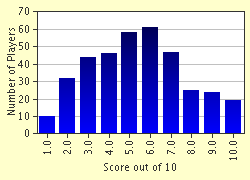Quiz Answer Key and Fun Facts
1. Son of a tribal chieftain, Genghis Khan nonetheless had to struggle from childhood - not only for political power, but also for survival. Why was his father's prestige useless to him?
2. Genghis's first task was to unite the various tribes of the Mongolian steppe under Mongol rule, which he accomplished by means of a shifting web of alliances and conquests. In what year was he acclaimed as ruler of all Mongolia?
3. As Genghis looked to expand his power beyond the steppes of Mongolia, neighboring powers either bolstered their defenses or tried to join his supporters. One people in particular were quick to ally themselves with him, and they were rewarded with high positions in the Mongol government. Even their alphabet was adapted to write Mongolian. Who were these people of western China?
4. At this time, China was divided into three kingdoms: the Jin in the northeast, the Hsi-Hsia in the northwest, and the Song Empire in the south. Genghis Khan, tempted by Chinese wealth, began his invasions soon after he had secured his power in Mongolia. Which of the three kingdoms was the first to fall, in 1209?
5. In 1214, the Mongols forced another Chinese kingdom to abandon one of their capital cities. Which kingdom had this unfortunate city been a part of?
6. As Genghis Khan's reputation grew, his remaining neighbors grew anxious. One neighbor, the Shah of Khwarazm in central Asia (around modern-day Afghanistan), made a fatal mistake in 1218 as a result of this fear. What was it?
7. What happened because of the Khwarazm Shah's mistake?
8. The Mongol army was organized into units called tumens, which traveled separately but could converge into armies. How large an army was Genghis Khan able to assemble when all his tumens joined?
9. As Genghis aged, he had to tackle the problem of succession and find some way of keeping his sons from killing each other after his death. Among how many sons did he divide his lands?
10. Which of his sons did Genghis pick as heir to his empire?
Source: Author
CellarDoor
This quiz was reviewed by FunTrivia editor
gtho4 before going online.
Any errors found in FunTrivia content are routinely corrected through our feedback system.

